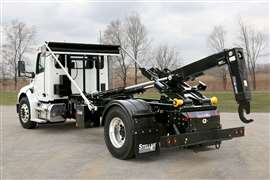Damen’s fully electric SOV can charge offshore
29 November 2023
Vessel is key to reducing emissions in maintenance of offshore wind farms
Damen Shipyards Group has introduced the fully electric Service Operations Vessel (SOV) 7017 E, which will help reduce emissions significantly in the maintenance of offshore wind farms.
“The product launch of the SOV 7017 E demonstrates that the technology is there to make offshore operations fully electric; the reduction in OPEX implied by harvesting energy directly from the offshore wind farm implies a business case for this model,” said Mark Couwenberg, Damen product manager for SOVs. “We cannot do this alone, however. To make this a reality will require collaboration throughout the chain, with shipbuilder, vessel operator and wind farm developer working together in pursuit of mutual benefit. We’re looking forward to participating in such cooperations as we take this concept forward. Together, we can make our offshore energy production more sustainable.”
The new vessel, which measures 70 m. by 17 m., has a 15MWhr battery with offshore charging capabilities thanks to Damen’s partnership with MJR Power & Automation, a UK-based company that previously had developed an offshore charging system for a crew transfer vessel.
 Damen Shipyards Group’s new fully electric SOV 7017 E will cut down on emissions in the maintenance of offshore wind farms. (Photo: Damen)
Damen Shipyards Group’s new fully electric SOV 7017 E will cut down on emissions in the maintenance of offshore wind farms. (Photo: Damen)
“The charging system is designed to be safe, convenient and reliable, with rapid connection and disconnection of the charge umbilical,” said Paul Cairns, MJR M.D. “From the outset of this project, the priority has been to ensure the safety of personnel and integrity of the vessel and offshore assets, under all conditions. Charging from an offshore asset represents optimal practicality, providing a means to reduce costs and emissions and optimize efficiency without placing personnel nor infrastructure in a potentially hazardous situation.”
The charging system uses the motion-compensated gangway to create a connection between the vessel and a turbine or substation offshore, much like the process of a personnel transfer.
The gangway is controlled from the wheelhouse, which requires no manual interaction with charging equipment, and the design also uses pre-existing offshore infrastructure to increase cost-efficiency.
Damen said charging is carried out while the vessel is in a low-power “green” DP mode, requiring less energy than the hotel load, and a full charge typically requires energy produced in just a few hours by a single turbine.
MJR designed the charging apparatus according to internationally recognized safety standards, including IEC/IEEE 80005-1, and the product has a DNV Approval in Principle (AIP) pending and is designed in accordance with forthcoming offshore charging standards under collaborative development by DNV UK and Norway.
MJR also developed a 4MW charger connector, sufficient for a 70-m. vessel, and the company is also working on a scaled-up 8MW version that will enable charging of larger vessels up to 90 m.
The SOV 7017 E has a lithium iron phosphate (LFP) battery instead of the more conventional lithium nickel manganese cobalt (NMC) battery type because Damen wanted to maximize the vessel’s sustainable credentials.
Damen, which operates 35 shipyards around the world, said LFP batteries are less dependent on sensitive raw materials, particularly cobalt, are better for safety performance, are less susceptible to ignition and, in the event of ignition, are easier to contain.
If the vessel cannot access electricity for a short period, Damen said the SOV 7017 E features full redundancy and is able to continue operations with conventional diesel propulsion, and the new craft also features DPX-DRIVETM layout, four azimuth thrusters for independent propulsion in any direction and considerably reduced underwater noise levels.
The 70-m.-long vessel has all the storage space, workshops and deck space to undertake the broad scope of transportation and work expected of it, and its 60 cabins provide comfortable accommodation for crew and up to 40 technicians.
According to Damen’s business case analysis that accounted for battery and charger costs, the price of CO2, charge times and other factors, the company concluded this venture would produce a return on investment within five to 15 years.
POWER SOURCING GUIDE
The trusted reference and buyer’s guide for 83 years
The original “desktop search engine,” guiding nearly 10,000 users in more than 90 countries it is the primary reference for specifications and details on all the components that go into engine systems.
Visit Now
STAY CONNECTED




Receive the information you need when you need it through our world-leading magazines, newsletters and daily briefings.
CONNECT WITH THE TEAM













